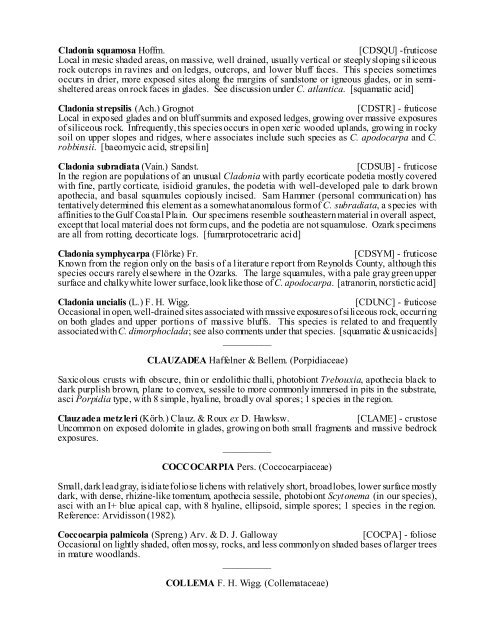lichens of the lower ozark region of missouri and arkansas
lichens of the lower ozark region of missouri and arkansas
lichens of the lower ozark region of missouri and arkansas
Create successful ePaper yourself
Turn your PDF publications into a flip-book with our unique Google optimized e-Paper software.
Cladonia squamosa H<strong>of</strong>fm. [CDSQU] -fruticose<br />
Local in mesic shaded areas, on massive, well drained, usually vertical or steeply sloping siliceous<br />
rock outcrops in ravines <strong>and</strong> on ledges, outcrops, <strong>and</strong> <strong>lower</strong> bluff faces. This species sometimes<br />
occurs in drier, more exposed sites along <strong>the</strong> margins <strong>of</strong> s<strong>and</strong>stone or igneous glades, or in semisheltered<br />
areas on rock faces in glades. See discussion under C. atlantica. [squamatic acid]<br />
Cladonia strepsilis (Ach.) Grognot [CDSTR] - fruticose<br />
Local in exposed glades <strong>and</strong> on bluff summits <strong>and</strong> exposed ledges, growing over massive exposures<br />
<strong>of</strong> siliceous rock. Infrequently, this species occurs in open xeric wooded upl<strong>and</strong>s, growing in rocky<br />
soil on upper slopes <strong>and</strong> ridges, where associates include such species as C. apodocarpa <strong>and</strong> C.<br />
robbinsii. [baeomycic acid, str epsilin]<br />
Cladonia subradiata (Vain.) S<strong>and</strong>st. [CDSUB] - fruticose<br />
In <strong>the</strong> <strong>region</strong> are populations <strong>of</strong> an unusual Cladonia with partly ecorticate podetia mostly covered<br />
with fine, partly corticate, isidioid granules, <strong>the</strong> podetia with well-developed pale to dark brown<br />
apo<strong>the</strong>cia, <strong>and</strong> basal squamules copiously incised. Sam Hammer (personal communication) has<br />
tentatively determined this element as a somewhat anomalous form <strong>of</strong> C. subradiata, a species with<br />
affinities to <strong>the</strong> Gulf Coastal Plain. Our specimens resemble sou<strong>the</strong>astern material in overall aspect,<br />
except that local material does not form cups, <strong>and</strong> <strong>the</strong> podetia are not squamulose. Ozark specimens<br />
are all from rotting, decorticate logs. [fumarprotocetraric acid]<br />
Cladonia symphycarpa (Flörke) Fr. [CDSYM] - fruticose<br />
Known from <strong>the</strong> <strong>region</strong> only on <strong>the</strong> basis <strong>of</strong> a literature report from Reynolds County, although this<br />
species occurs rarely elsewhere in <strong>the</strong> Ozarks. The large squamules, with a pale gray green upper<br />
surface <strong>and</strong> chalky white <strong>lower</strong> surface, look like those <strong>of</strong> C. apodocarpa. [atranorin, norstictic acid]<br />
Cladonia uncialis (L.) F. H. Wigg. [CDUNC] - fruticose<br />
Occasional in open, well-drained sites associated with massive exposures <strong>of</strong> siliceous rock, occurring<br />
on both glades <strong>and</strong> upper portions <strong>of</strong> massive bluffs. This species is related to <strong>and</strong> frequently<br />
associated with C. dimorphoclada; see also comments under that species. [squamatic & usnic acids]<br />
__________<br />
CLAUZADEA Haffelner & Bellem. (Porpidiaceae)<br />
Saxicolous crusts with obscure, thin or endolithic thalli, photobiont Trebouxia, apo<strong>the</strong>cia black to<br />
dark purplish brown, plane to convex, sessile to more commonly immersed in pits in <strong>the</strong> substrate,<br />
asci Porpidia type, with 8 simple, hyaline, broadly oval spores; 1 species in <strong>the</strong> <strong>region</strong>.<br />
Clauz adea metz leri (Körb.) Clauz. & Roux ex D. Hawksw. [CLAME] - crustose<br />
Uncommon on exposed dolomite in glades, growing on both small fragments <strong>and</strong> massive bedrock<br />
exposures.<br />
__________<br />
COCCOCARPIA Pers. (Coccocarpiaceae)<br />
Small, dark lead gray, isidiate foliose <strong>lichens</strong> with relatively short, broad lobes, <strong>lower</strong> surface mostly<br />
dark, with dense, rhizine-like tomentum, apo<strong>the</strong>cia sessile, photobiont Scytonema (in our species),<br />
asci with an I+ blue apical cap, with 8 hyaline, ellipsoid, simple spores; 1 species in <strong>the</strong> <strong>region</strong>.<br />
Reference: Arvidisson (1982).<br />
Coccocarpia palmicola (Spreng.) Arv. & D. J. Galloway [COCPA] - foliose<br />
Occasional on lightly shaded, <strong>of</strong>ten mossy, rocks, <strong>and</strong> less commonly on shaded bases <strong>of</strong> larger trees<br />
in mature woodl<strong>and</strong>s.<br />
__________<br />
COLLEMA F. H. Wigg. (Collemataceae)


